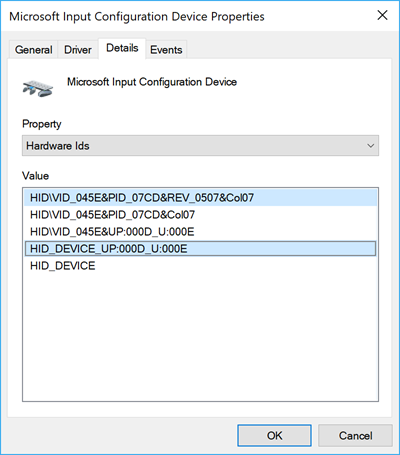HidDevice Class
Definition
Important
Some information relates to prerelease product that may be substantially modified before it’s released. Microsoft makes no warranties, express or implied, with respect to the information provided here.
Represents a top-level collection and the corresponding device.
public ref class HidDevice sealed : IClosable/// [Windows.Foundation.Metadata.ContractVersion(Windows.Foundation.UniversalApiContract, 65536)]
/// [Windows.Foundation.Metadata.MarshalingBehavior(Windows.Foundation.Metadata.MarshalingType.Agile)]
class HidDevice final : IClosable[Windows.Foundation.Metadata.ContractVersion(typeof(Windows.Foundation.UniversalApiContract), 65536)]
[Windows.Foundation.Metadata.MarshalingBehavior(Windows.Foundation.Metadata.MarshalingType.Agile)]
public sealed class HidDevice : System.IDisposablePublic NotInheritable Class HidDevice
Implements IDisposable- Inheritance
- Attributes
- Implements
Windows requirements
| Device family |
Windows 10 (introduced in 10.0.10240.0 - for Xbox, see UWP features that aren't yet supported on Xbox)
|
| API contract |
Windows.Foundation.UniversalApiContract (introduced in v1.0)
|
Examples
For a complete sample that demonstrates how to use this class, see Custom HID device sample.
The following example demonstrates how a UWP app built with XAML and C# uses the GetDeviceSelector method to create a selector for a specific HID device (in this case, Microsoft Input Configuration Device) and then uses FromIdAsync method to open a connection to that device.
Note
This snippet attempts to find a HID device that might not be present on your system. To successfully test the code on your system, you should update vendorId, productId, usagePage, usageId with valid values.
- Open Device Manager
- Expand Human Interface Devices
- Locate a HID device (for this example we chose Microsoft Input Configuration Device)
- Right click the device and select Properties
- In Properties, select the Details tab
- On the Details tab, select Hardware Ids from the Property drop down
- The HID details are displayed in the Value box:

using System;
using System.Linq;
using Windows.Devices.Enumeration;
using Windows.Devices.HumanInterfaceDevice;
using Windows.Storage;
using Windows.UI.Xaml.Controls;
namespace HIDdeviceTest
{
public sealed partial class MainPage : Page
{
public MainPage()
{
this.InitializeComponent();
EnumerateHidDevices();
}
// Find HID devices.
private async void EnumerateHidDevices()
{
// Microsoft Input Configuration Device.
ushort vendorId = 0x045E;
ushort productId = 0x07CD;
ushort usagePage = 0x000D;
ushort usageId = 0x000E;
// Create the selector.
string selector =
HidDevice.GetDeviceSelector(usagePage, usageId, vendorId, productId);
// Enumerate devices using the selector.
var devices = await DeviceInformation.FindAllAsync(selector);
if (devices.Any())
{
// At this point the device is available to communicate with
// So we can send/receive HID reports from it or
// query it for control descriptions.
info.Text = "HID devices found: " + devices.Count;
// Open the target HID device.
HidDevice device =
await HidDevice.FromIdAsync(devices.ElementAt(0).Id,
FileAccessMode.ReadWrite);
if (device != null)
{
// Input reports contain data from the device.
device.InputReportReceived += async (sender, args) =>
{
HidInputReport inputReport = args.Report;
IBuffer buffer = inputReport.Data;
// Create a DispatchedHandler as we are interracting with the UI directly and the
// thread that this function is running on might not be the UI thread;
// if a non-UI thread modifies the UI, an exception is thrown.
await this.Dispatcher.RunAsync(
CoreDispatcherPriority.Normal,
new DispatchedHandler(() =>
{
info.Text += "\nHID Input Report: " + inputReport.ToString() +
"\nTotal number of bytes received: " + buffer.Length.ToString();
}));
};
}
}
else
{
// There were no HID devices that met the selector criteria.
info.Text = "HID device not found";
}
}
}
}
Remarks
For more information about using this class, including limitations, see Supporting human interface devices (HID) and Custom HID device sample.
Apps that use this class to access a HID device must include specific DeviceCapability data in the Capabilities node of its manifest. This data identifies the device and its purpose (or function). For more information, see How to specify device capabilities for HID.
Properties
| ProductId |
Gets the product identifier for the given HID device. |
| UsageId |
Gets the usage identifier for the given HID device. |
| UsagePage |
Gets the usage page of the top-level collection. |
| VendorId |
Gets the vendor identifier for the given HID device. |
| Version |
Gets the version, or revision, number for the given HID device. |
Methods
| Close() |
Closes the connection between the host and the given HID device. |
| CreateFeatureReport() |
Creates the only, or default, feature report that the host will send to the device. |
| CreateFeatureReport(UInt16) |
Creates a feature report, identified by the reportId parameter, that the host will send to the device. |
| CreateOutputReport() |
Creates the only, or default, output report that the host will send to the device. |
| CreateOutputReport(UInt16) |
Creates an output report, identified by the reportId parameter, that the host will send to the device. |
| Dispose() |
Performs application-defined tasks associated with freeing, releasing, or resetting unmanaged resources. |
| FromIdAsync(String, FileAccessMode) |
Opens a handle to the device identified by the deviceId parameter. The access type is specified by the accessMode parameter. |
| GetBooleanControlDescriptions(HidReportType, UInt16, UInt16) |
Retrieves the descriptions of the boolean controls for the given HID device. |
| GetDeviceSelector(UInt16, UInt16, UInt16, UInt16) |
Retrieves an Advanced Query Syntax (AQS) string based on the given usagePage, usageId, vendorId, and productId. |
| GetDeviceSelector(UInt16, UInt16) |
Retrieves an Advanced Query Syntax (AQS) string based on the given usagePage and usageId. |
| GetFeatureReportAsync() |
Asynchronously retrieves the first, or default, feature report from the given HID device. |
| GetFeatureReportAsync(UInt16) |
Asynchronously retrieves a feature report, identified by the reportId parameter, for the given HID device. |
| GetInputReportAsync() |
Asynchronously retrieves the default, or first, input report from the given HID device. |
| GetInputReportAsync(UInt16) |
Asynchronously retrieves an input report, identified by the reportId parameter, from the given HID device. |
| GetNumericControlDescriptions(HidReportType, UInt16, UInt16) |
Retrieves the descriptions of the numeric controls for the given HID device. |
| SendFeatureReportAsync(HidFeatureReport) |
Sends an feature report asynchronously from the host to the device. |
| SendOutputReportAsync(HidOutputReport) |
Sends an output report asynchronously from the host to the device. |
Events
| InputReportReceived |
Establishes an event listener to handle input reports issued by the device when either GetInputReportAsync() or GetInputReportAsync(System.UInt16 reportId) is called. |